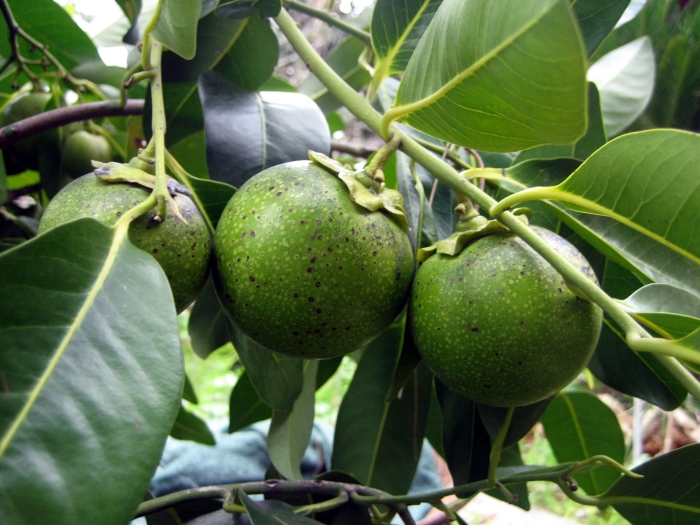Black Sapote
(Diospyros nigra)
Black Sapote (Diospyros nigra)
/
/

Yonygg
Public domain
Image By:
Yonygg
Recorded By:
Copyright:
Public domain
Copyright Notice:
Photo by: Yonygg | License Type: Public domain | License URL: https://creativecommons.org/public-domain/ | Uploader: Yonygg | Publisher: Wikimedia Commons | Title: Black_Sapote_1.JPG | Notes: {{Information |Description={{en|1=''Mimulus aurantiacus'' in Mission Trails Regional Park, [[San Diego, California]], USA. This is one of the darker red ones in the area; there were paler red and some orange ones too.}} |Source=Own work by uploader |Autho |






























Estimated Native Range
Summary
Diospyros nigra, commonly known as Black Sapote, is an evergreen tree native to lowland rainforests and cloud forests in Mexico, Central America and Colombia in South America. It is a tropical fruit tree closely related to the persimmon and typically grows to a height of over 25 m (82 ft). The Black Sapote has a dense, rounded canopy with glossy green leaves, providing a lush, tropical appearance. The fruit is tomato-like, measuring 5–10 cm (2.0–3.9 in) in diameter, with an inedible skin that matures from olive to a deep yellow-green when ripe. The pulp is initially white and inedible but transforms into a dark, chocolate pudding-like consistency and flavor when fully ripe, which is highly valued for its culinary uses.
The Black Sapote is appreciated for its unique fruit, which can be used in desserts and smoothies, and for its ornamental value in tropical and subtropical landscapes. It is often planted in home gardens, orchards, and as a street tree in suitable climates. The tree’s slow initial growth accelerates after the first few years, and mature trees should be spaced 10-12m apart. While it can tolerate light frosts, the Black Sapote requires protection from heavy frost and prefers consistently moist soil conditions. It thrives in full sun and soils with medium drainage. Propagation is typically from seed, which remains viable for several months and germinates in about 30 days, though seedless varieties can be propagated by air-layering or shield budding. Potential problems include fruit fly infestations and root rot in poorly drained soils. The tree is not known for being invasive outside its native range.CC BY-SA 4.0
The Black Sapote is appreciated for its unique fruit, which can be used in desserts and smoothies, and for its ornamental value in tropical and subtropical landscapes. It is often planted in home gardens, orchards, and as a street tree in suitable climates. The tree’s slow initial growth accelerates after the first few years, and mature trees should be spaced 10-12m apart. While it can tolerate light frosts, the Black Sapote requires protection from heavy frost and prefers consistently moist soil conditions. It thrives in full sun and soils with medium drainage. Propagation is typically from seed, which remains viable for several months and germinates in about 30 days, though seedless varieties can be propagated by air-layering or shield budding. Potential problems include fruit fly infestations and root rot in poorly drained soils. The tree is not known for being invasive outside its native range.CC BY-SA 4.0
Plant Description
- Plant Type: Tree
- Height: 30-80 feet
- Width: 20-35 feet
- Growth Rate: Slow
- Flower Color: N/A
- Flowering Season: Spring, Fall
- Leaf Retention: Evergreen
Growth Requirements
- Sun: Full Sun, Part Shade
- Water: Medium
- Drainage: Medium
Common Uses
Bee Garden, Bird Garden, Butterfly Garden, Edible*Disclaimer: Easyscape's listed plant edibility is for informational use. Always verify the safety and proper identification of any plant before consumption., Fragrant, Low Maintenance
Natural Habitat
native to lowland rainforests and cloud forests in Mexico, Central America and Colombia in South America
Other Names
Common Names: Chocolate Pudding Fruit, Black Soapapple
Scientific Names: , Diospyros digyna, Diospyros nigra, Diospyros decandra, Diospyros sapota, Diospyros pauciflora, Diospyros obtusifolia, Diospyros edulis, Diospyros sapotanigera, Diospyros tliltzapotl
GBIF Accepted Name: Diospyros nigra (J.F.Gmel.) Perrier